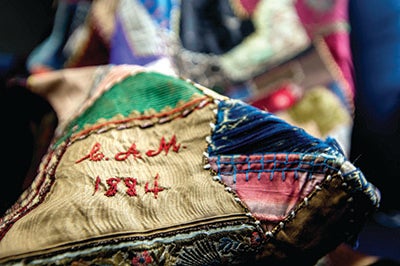Clyde, Time Was: Every quilt told a story
Published 12:00 am Sunday, October 14, 2018

- The maker of this quilt stitched in her initials and the year, 1884. JON C. LAKEY / SALISBURY POST
Time was, we were covered up with quilts.
Quilte — from the French cuilte from the Latin culcita for mattress.
We slept under “the kivers,” handmade with care and hard work, the culmination of planting and hoeing cotton, picking, carding, spinning, weaving just for the yarn goods for the quilt tops. Needlework was an art, practiced by every school girl, mother and homemaker.
When is the last time you threaded a needle to do a little “hand work” or sew on a button? Could you even find a needle in a haystack? Who has the eyes to thread it?
Aunt Jane of Kentucky noted, “There is a heap of comfort in making quilts, just to sit and sort over pieces and call to mind that this piece or that is of the dress of a loved friend now departed.”
Cotton was the fabric of our lives. With cotton factories everywhere you turned, the gin was invented in 1796 to take the seeds out faster. That staple fabric was replaced with corduroy, origin unknown, and denim, de Nimes, France in 1695.
How many pairs of jeans for each person in the good ol’ U.S. of A?
Rowan County’s textile belt was the ninth biggest producer in the state, with the Salisbury Cotton Mills, Vance Cotton Mill and Kessler Cotton Mill.
Irving Kristol in 1952 was the first to call people “out of their cotton picking minds.” Yankees still are.
Here’s a simple ABCs of sewing for a sample of your own handiwork for piecework, sampler or stitches in time.
A: Applique: Fabric sewn to fabric.
B: Batting for bolster pillows with goose feathers.
C: Coverlets or tufted counterpanes.
D: Darning eggs are extinct.
E: Edging lace. Often crocheted or tatting.
F: Featherstitching or briar stitching on crazy quilts — also French knots.
G: Gloves. Hand knit to fit.
H: Hemstitch on napkins or hankies.
I: Inserts of lace or pleated.
J: Jacquard looms for bedspreads.
K: Knitting machines for socks.
L: Looms for rag rugs by Fred Parnell of Tyro.
M: Monograms on your underwear.
N: Niddy noddy for coating skeins.
O: Overstitching or over-edging held the binding tight.
P: Pique or waffle weave.
Q: Quilling in paper or ribbons.
R: Remnants to save for scraps that people throw out.
S: Spools, wooden.
T: Thimbles could be sterling.
U: Unbleached muslin used for lining.
V: Velvets for crazy quilts in 1890.
W: Wheel for spinning sits in a corner.
X: Xmas, handmade stockings and gifts.
Y: Yarn, knitting or to tie up.
Z: Zippers for tight fit.
Patterns imitated life — such as anvil, sawtooth, ships wheel, golden maze, whig rose, spider web, Job’s tears, drunkard’s path.
Turkey red dye would not fade, indigo would.
Ms. Jane Long made a quilt with 21,840 pieces, using 20 spools (wooden) of thread.
Quilting bees made for production and gossip, both necessary to keep things heated up on long winter nights. Some got hot.
So cherish your hand-me-down, inherited, handcrafted heirlooms that hark back to harmony, honey, cause they ain’t making no quilts no mo’.
The old grey goose is dead, go tell Aunt Rhody.
Clyde is a Salisbury artist.

